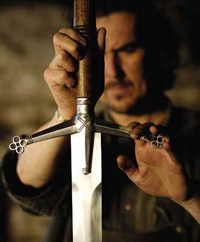 Whatever their ancient origins - Celtic, Norse or Norman-French - by the 13th century the clan system was well established in the Highlands of Scotland. It was a distinct Gaelic tribal culture, which, in its 15th century heyday, threatened the authority of the Stewart monarchy itself. Though increasingly brought into contact with the rest of Scotland, the clan system survived largely intact until its dismantling in the years following 1746, a consequence of the failure of the final Jacobite uprising on the bloody field of Culloden.
Whatever their ancient origins - Celtic, Norse or Norman-French - by the 13th century the clan system was well established in the Highlands of Scotland. It was a distinct Gaelic tribal culture, which, in its 15th century heyday, threatened the authority of the Stewart monarchy itself. Though increasingly brought into contact with the rest of Scotland, the clan system survived largely intact until its dismantling in the years following 1746, a consequence of the failure of the final Jacobite uprising on the bloody field of Culloden.
The clans - their heyday and their demise
In Gaelic, the word clann means family or children. The clan system was completely separated by language, custom and geography.
The clans lived off the land more or less self-sufficiently, with cattle as their main wealth. Stealing cattle (sometimes in order to survive) was widespread, as were territorial disputes between clans. Land was owned by the chief, rather than individual clansmen, and was held either directly from the Crown or from other superior clan chiefs.
The most powerful chiefs in some places kept expensive courts and retainers for prestige and had virtual autonomy over matters of law and order within their territory. Not all of a clan chieftain's preoccupations were war-like. For example, an important member of the chief's retinue was the bard, who could both compose an epic poem, perhaps recalling a feat of heroism in battle, and recite lineage, which was an important part of his role as the recorder of the clan's history. The clan piper was another hereditary post, of whom the MacCrimmons, hereditary pipers to the MacLeods, were perhaps the most famous.
However, by the 18th century, with agricultural improvements spreading from the Lowlands and with some road-building taking place which made communications easier, clans and their chiefs were brought more and more into contact with 'southern' ways. Thus, even without the shock of Culloden and the violent reaction of the Lowland authorities (which included the proscription or banning of tartan and the forfeiting of rebel clan chief's estates) the old clan system was gradually being absorbed into a modern economic society.
苏格兰的家族体系,无论是源自凯尔特人,斯堪的那维亚还是诺曼-法国人,到13世纪时,在苏格兰高地上家族制度已极具规模。家族是盖尔人独特的部落文化的一部分,到15世纪的鼎盛时期,家族体系对斯图亚特王朝的统治甚至构成了威胁。各家族之间相互联系,直到1746年詹姆士派被镇压的卡洛登一战后,家族体系才逐步瓦解。
家族制度的兴盛和消亡
在盖尔语中,clan的意思是家庭和孩子。家族是完全按照语言、习惯和地理方位而划分的。
各个家族都拥有土地,基本可以自给自足,但他们主要的财产是牛。从别人家偷牛(有时是生活所迫)是很普遍的,家族之间的地盘争端也层出不穷。土地归家族首领所有,土地的最高拥有人是地位更高的家族首领或国王。
最有权利的家族首领拥有豪华的庭院和众多仆从以显示身份,且在法律和规则方面拥有无形的自主权。当然,家族首领生活的全部并不是争斗,家族中的重要人物之一是诗人,他们负责谱写经典诗歌,歌颂战争中的英雄精神,或陈述宗谱。家族的吹奏手也是家族中的重要人物,其中最著名的如MacCrimmons以及世袭的麦克劳德(MacLeods)。
18世纪,随着低地农业的发展和交通的日益便利,家族和家族首领与南部英格兰地区之间的沟通越来越频繁。所以,即使没有卡洛登一战和低地地区的过激反应(禁裙令和没收反叛家族首领的财产),古老的家族制度也会逐渐融入到新型的商业社会中。
点击查看本频道更多精彩内容